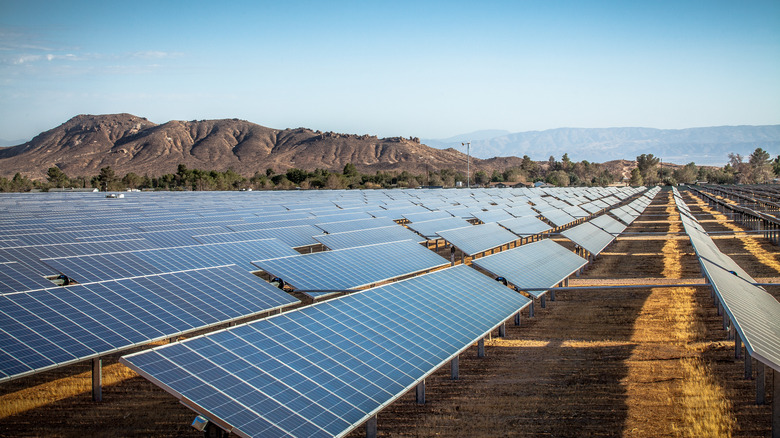A Brief Summary Of Solar Energy
Reliance on fossil fuels brings many problems, from damage to the Earth to pollution of the atmosphere and waters. Solar energy offers power without the need to burn fossil fuels. In its basic form, it needs no distribution grid because it comes down from the sky. It's under intensive development as a source of electric power, but sometimes its applications can be much smaller and simpler.
Solar Energy Offers Many Benefits
Solar Energy Offers Many Benefits
Solar energy offers clean power. It doesn't present the risk of a nuclear spill, but it is in fact a release of radiation, only some of which is visible light. It can be scaled to any size or complexity, from warming a room through a window to powering a utility grid.
The Union of Concerned Scientists lists numerous benefits, beginning with solar energy being inexhaustible and free. The attractiveness of solar power production varies with the economics of investing in equipment, and cost competition from fossil fuels. Scientific American estimates the cost of solar power falling below the current average power cost by 2018 or 2020.
Common Ways to Harvest Solar Energy
Common Ways to Harvest Solar Energy
Solar radiant heat is easily captured by simple glass greenhouses, and through residential windows. "Concentrated" solar energy uses huge arrays of mirrors to focus sunlight on a central tower, which heats water to generate steam that can be used to generate electricity.
Photovoltaic (PV) cells convert sunlight directly to electricity through the photoelectric effect. NASA describes how the silicon semiconductors in the cells capture energy from sunlight's photons, which dislodge electrons in the semiconductor, creating a current. Groups of cells form modules, and modules combine into larger arrays. These can be configured to produce any combination of voltage and current.
Large-Scale and Small-Scale Solar Energy Applications
Large-Scale and Small-Scale Solar Energy Applications
The U.S. Energy Information Administration defines "utility-scale" solar plants as those generating at least one megawatt of electricity. California leads the United States in solar energy production; in 2013, 1.9 percent of California's power came from solar, and by 2014, the number more than doubled to 5 percent. The U.S. EIA puts the country's production of photovoltaic solar power at 16,000 megawatthours (MWh) in 2005, and rising to 15,874,000 MWh in 2014. Small-scale applications of solar power also prove useful, like the 5-watt units installed on Ohio Highway Patrol cruisers to power on-board electronic equipment without needing to run the car's engine, thus saving fossil fuel and battery life.
A Variety of Solar Power Uses
A Variety of Solar Power Uses
The United Nations estimates that in many climates, residential solar thermal systems can supply 50 to 75 percent of a household's hot water needs. Small stand-alone PV units can power roadside warning signs or even landscape lighting, but since they're off the grid, they need batteries to store power when sunlight isn't available. Residential solar power arrays typically connect to the grid as a backup, and they have the benefit of allowing the owner to sell excess power, depending on local power provider regulations.
References
- Union of Concerned Scientists: Benefits of Renewable Energy Use
- Scientific American: Smaller, Cheaper, Faster: Does Moore's Law Apply to Solar Cells?
- NASA Science News: How Do Photovoltaics Work?
- U.S. Energy Information Administration: California First State to Generate More than 5% of Electricity from Utility-Scale Solar
- U.S. Energy Information Administration: Net Generation from Renewable Sources: Total (All Sectors), 2005-January 2015
- Ohio State Highway Patrol: Patrol Goes Green by Equipping Fleet with Solar Panels to Save Fuel and Extend Vehicle Battery Life
- UN Chronicle: The Promise Of Solar Energy: A Low-Carbon Energy Strategy for the 21st Century
- U.S. Department of Energy: Grid-Connected Renewable Energy Systems
Cite This Article
MLA
Silbajoris, Alex. "A Brief Summary Of Solar Energy" sciencing.com, https://www.sciencing.com/brief-summary-solar-energy-5806468/. 9 March 2018.
APA
Silbajoris, Alex. (2018, March 9). A Brief Summary Of Solar Energy. sciencing.com. Retrieved from https://www.sciencing.com/brief-summary-solar-energy-5806468/
Chicago
Silbajoris, Alex. A Brief Summary Of Solar Energy last modified March 24, 2022. https://www.sciencing.com/brief-summary-solar-energy-5806468/
